VARIOUS WORMS
This
page started July 3, 2001 Updated
12/22/2023
Images
and contents on this page copyright ©2001-2023
Richard M.
Dashnau
Go
back to my home page, Welcome
to
rickubis.com
Go
back to the RICKUBISCAM
page.
At
7am on 11/04/2023
I was walking home with my dog. There were occasional
wet spots in the sidewalk from the sprinklers, and I watched for
earthworms
so I could prevent myself, or the dog, from stepping on them.
I noticed something that resembled an earthworm, but then
realized it wasn't moving like one.
When I realized what I'd
found, I had to stop and take some pictures. I'd found a Land
Planarian! They are also known as "hammerhead worms". Way
back in
2001, a
friend of mine had
found some of these in his garden. He didn't know what it was, and I
didn't either, until I'd looked found information about them. He let me
use his
pictures back then, and I showed them on this page (they're further
down).
I'd never
seen one myself until now, November 2023. I took some pictures and
video clips of it on the sidewalk--which wasn't that easy with my dog
pulling on the leash
because she wanted to get home. I
remembered a few things about these animals: 1) they are an
introduced, invasive species; 2) they are predators of earthworms,
and
are a potential threat to their survival; 3) they can regenerate if
their bodies are cut into pieces. For those reasons, I tried to dispose
of it by shredding it.
A few days later, 11/06/2023
I found another
one, about 10 yards from where I'd found the first one and at
about the same time. I took more pictures and video clips
on
the sidewalk along with my my Geologist's Scale (I usually have one in
my pocket).Then I decided to carry it back with me, by
letting it crawl onto the scale .
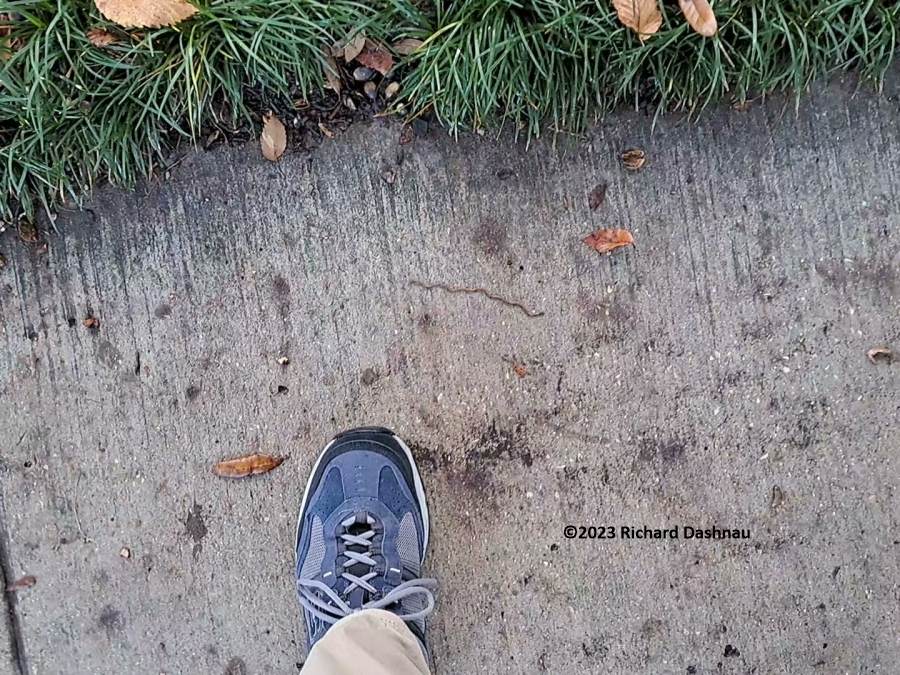
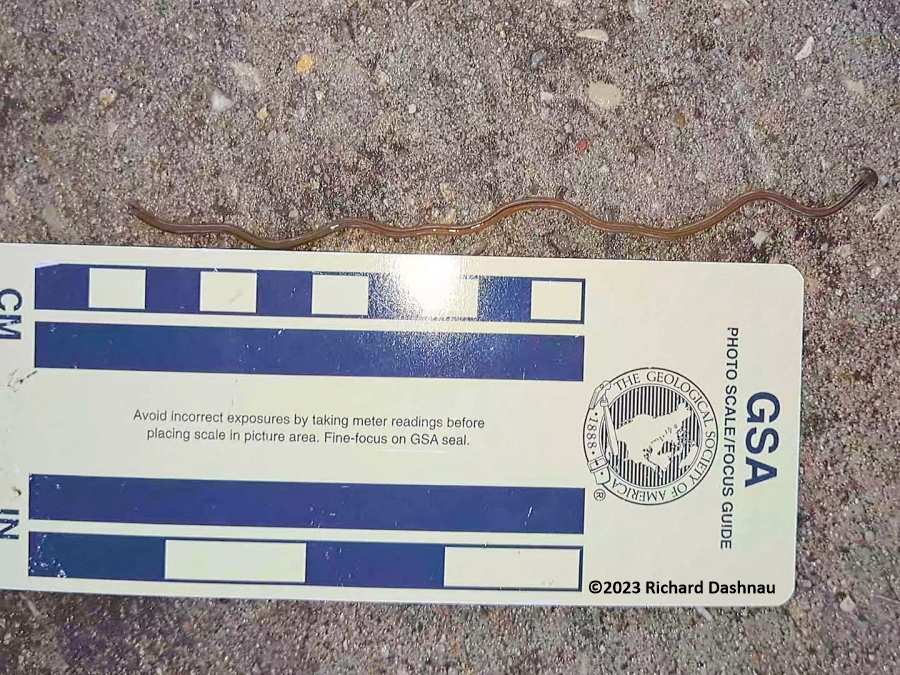
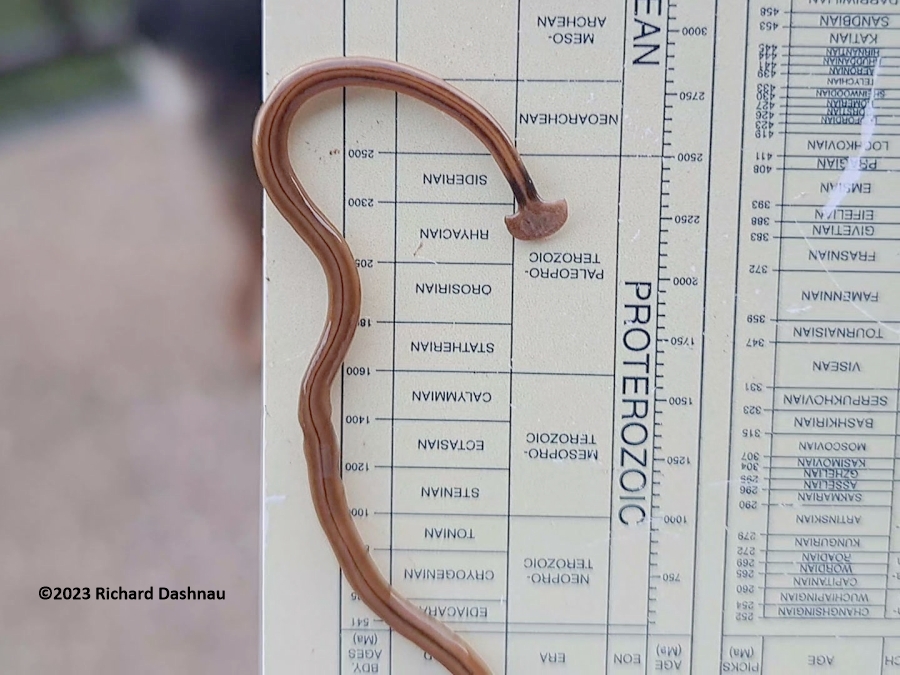
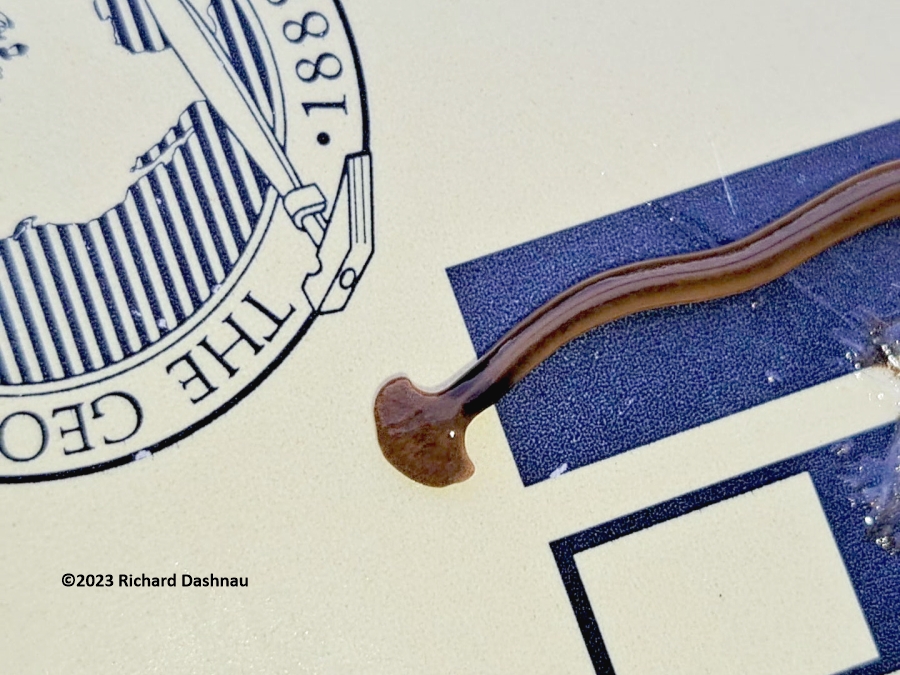
The
dog
and I usually end our walk with a 15-minute pause at the top step
to enjoy the morning. While sitting there, I was able to take more
photographs of the Planarian
as it crawled and climbed on the
scale. The closer pictures show dark lines on a brown background, with
a black "collar" open at the top that goes around the neck.
So,
this one was probably a Bipalium
kewense. After taking lots of pictures
and video clips, we went inside, and this time I placed the worm into a
plastic sample bag
and placed that into my freezer. Most
of these images are frames from the video clips. I've edited some of
those together into the video linked here.
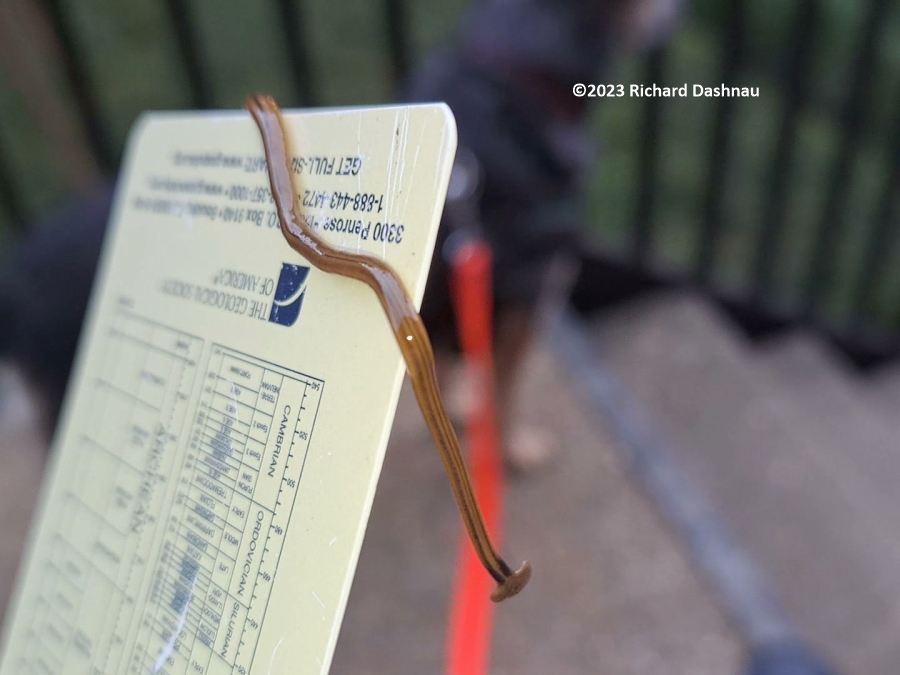
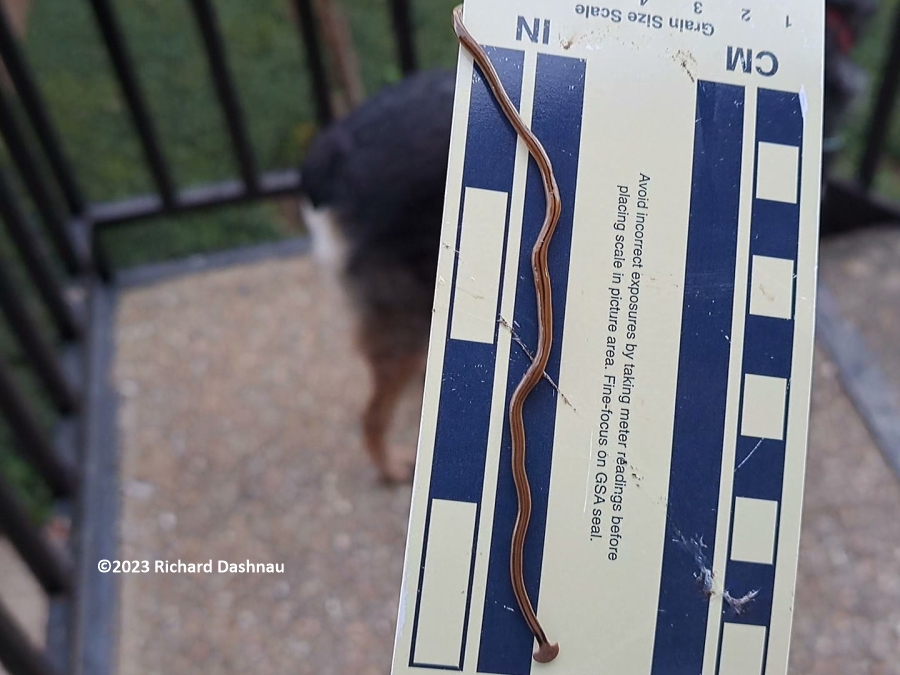
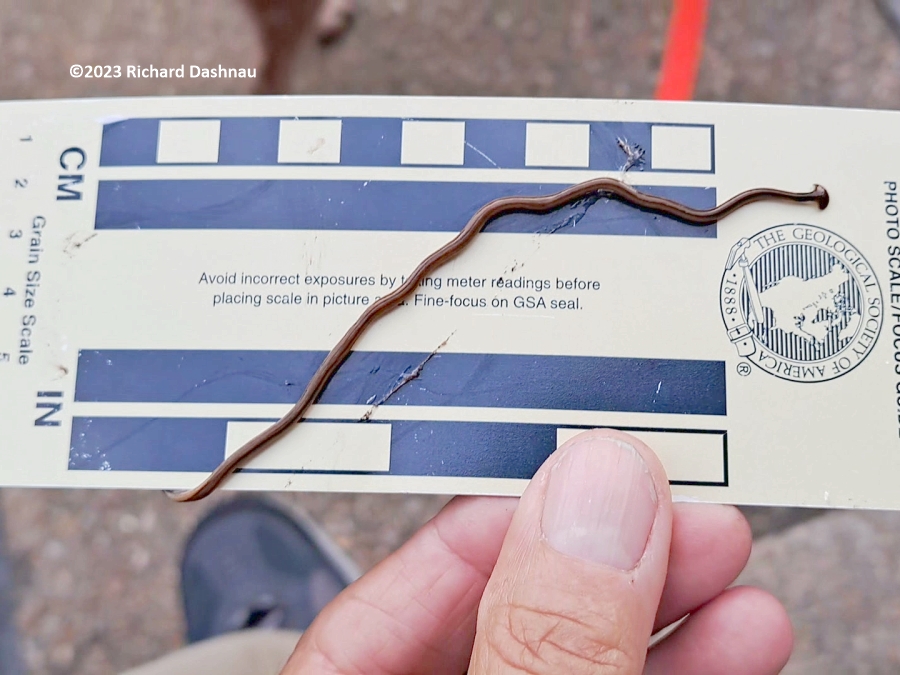

Flatworms
move
on a layer of slime they produce, propelled by actions of very
tiny hairs (cilia). Their head has "eyes numerous, minute,
around
the dorsal head within
margin, crowded in lateral neck region,
sparsely in staggered submarginal row along body." (A revision of the
cosmopolitan land planarian Bipalium kewense Moseley,
1878
(Turbellaria: Tricladida: Terricola) by L. Winsor).
Inspired by this
encounter, I updated my limited knowledge about this species. Along
with the 3 items mentioned above, this species (Bipalium kewense)
and another
flatworm (Bipalium
adventitium) also carry Tetrodotoxin--which is a potent
neurotoxin.
This was described in this study: Confirmation and
Distribution
of Tetrodotoxin
for the First Time in Terrestrial Invertebrates: Two
Terrestrial Flatworm Species (Bipalium adventitium and Bipalium
kewense) by Stokes, Ducey et. al. From the abstract:
"
Tetrodotoxin (TTX) is a low molecular weight compound that acts
by
blocking voltage-gated sodium channels, inducing paralysis. However,
the origins and ecological
functions of TTX in most taxa remain
mysterious. "
While the study proves that the worms
have TTX, it does not confirm what the neurotoxin is used for.
Observations of these Land Planarians feeding on worms show what
appears
to be paralysis of the prey after it is attacked. It's also probable
that the TTX also works as a deterrent to predation upon these
flatworms. Here's a partial list
of other organisms that carry
TTX-some of which may be familiar to you: Blue-ringed
octopus,
various pufferfish, several starfish and... Eastern Newts
(Notophthalmus
viridescens)--yes,
the species of newt that we find at BBSP. Most sources I've
found
suggest that the various species of invasive terrestrial flatworms
that
have appeared in the U.S. were carried inside the soil of various
potted plants. They have been found in the U.S. since the early 1900s.
Apparently my adventures with
invasive flatworms were not over. On 11/29/2023
(about 3 weeks after I found the hammerhead worm), I was taking a very
short walk with
my
dog at 9:20pm. On my way back, about 5 steps away from the
stairway to my apartment, I noticed something dark and shiny at the
edge of the sidewalk. And, it
was moving. I put the dog
inside and hurried back out to examine the creature. This was
another worm, almost black in the artificial light, and very shiny. It
was not an
earthworm and it was crawling back into the
shadows. I captured it and brought it inside to photograph.
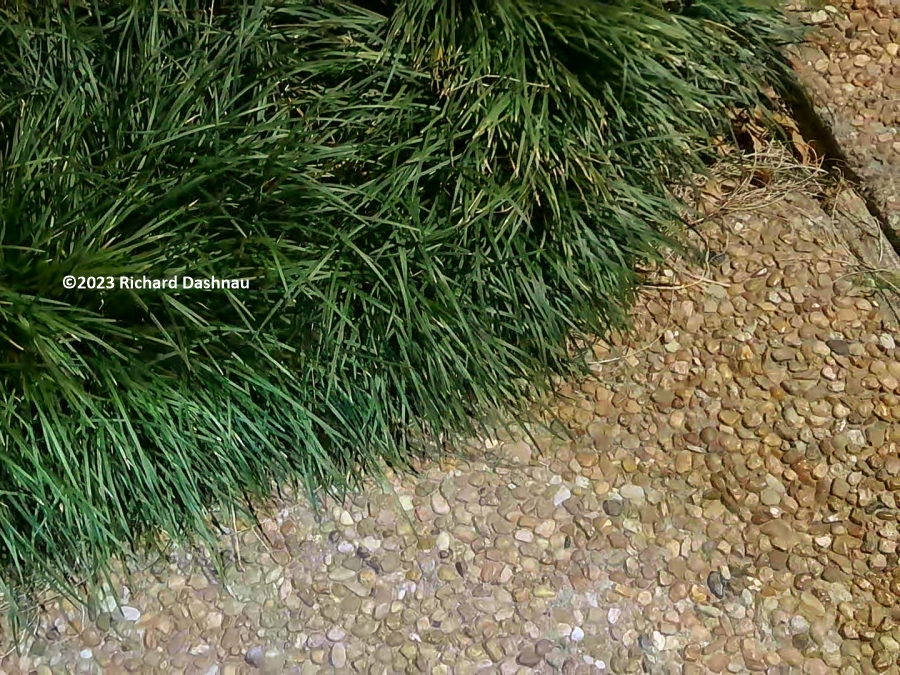
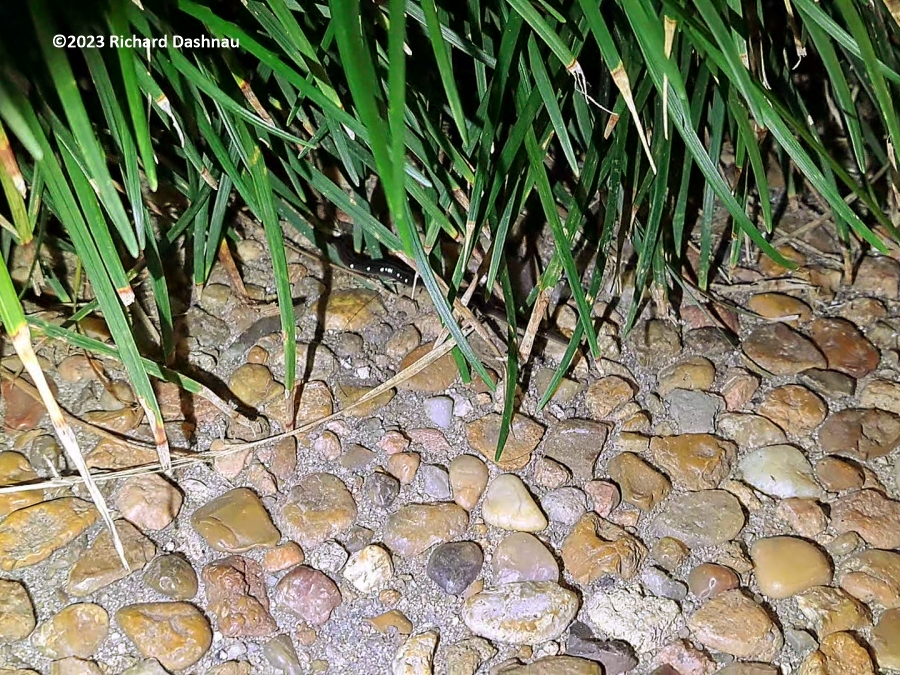
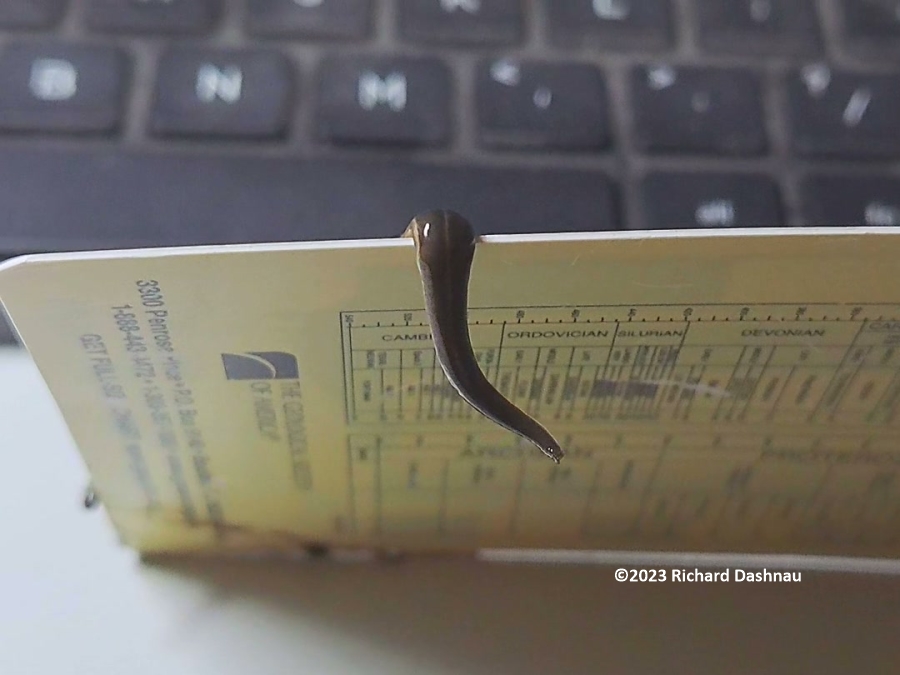
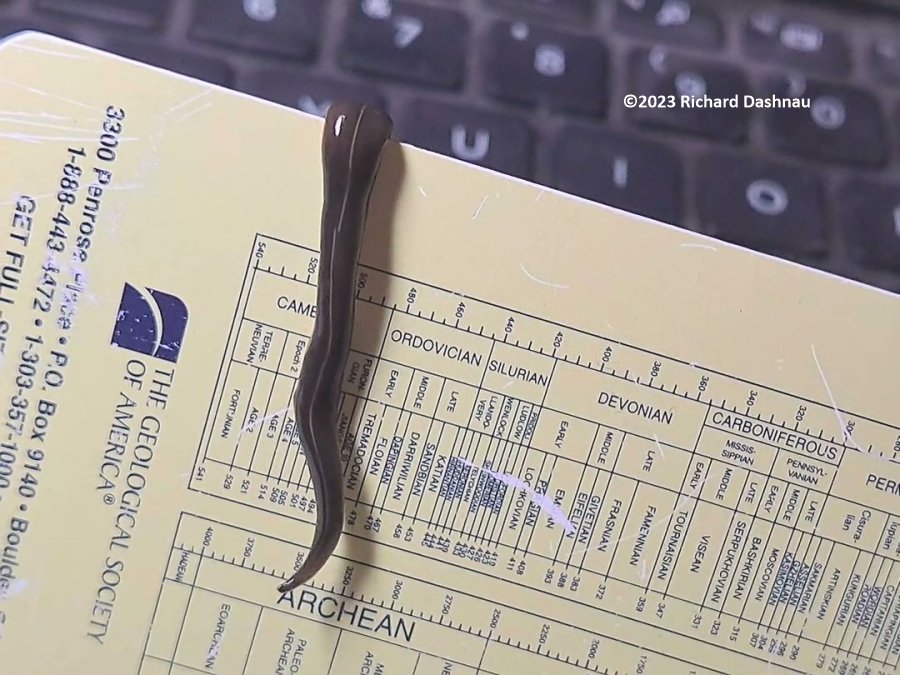
I
had a difficult time with the various lights I had available, but I was
able to bring out better color. I could see a faint light line along
the center of the back. A search online
revealed that I'd found a different
species of flatworm; a New Guinea Flatworm (Platydemus
manokwari).
This
species is known as a predator of molluscs, posing a special threat to
terrestrial snails where this worm has been introduced. Apparently P.
manokwari has wiped
out some species of snails in island
environments where it has appeared. However, it isn't as successful
eating slugs, or snails that produced large amounts of slime.
I
briefly wondered if they'd be effective against Apple Snails...but
those aren't a terrestrial species. I know that introducing a foreign
species to control an invasive
foreign species usually does NOT work well, but since the worms are
apparently already
here....
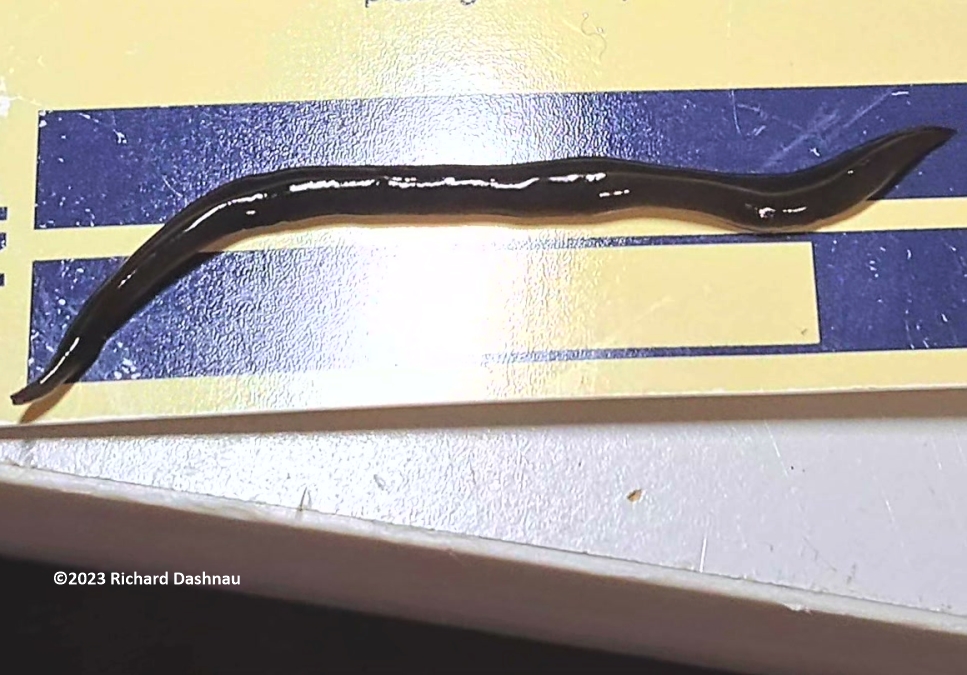
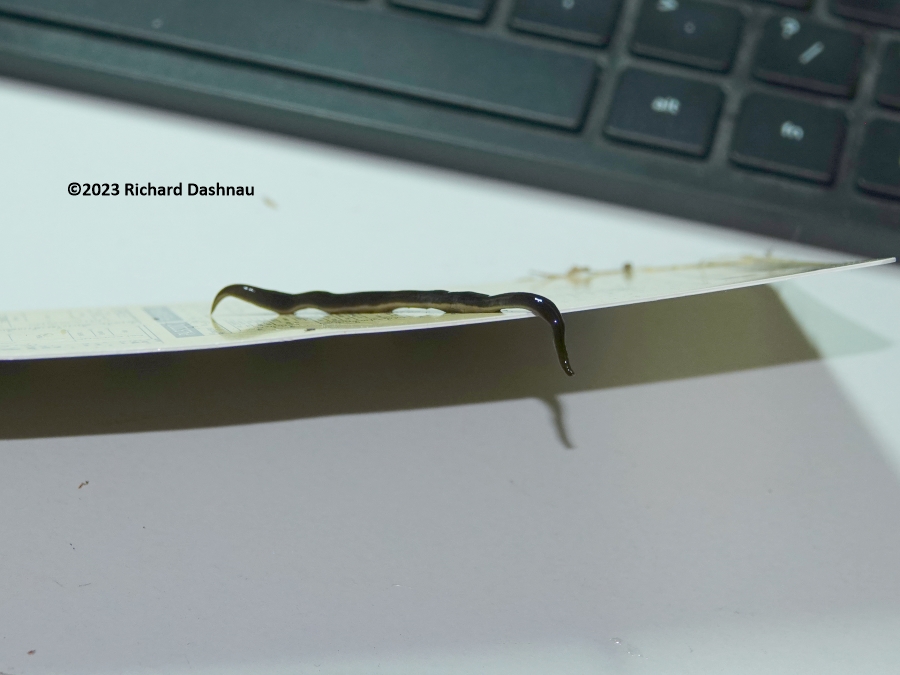
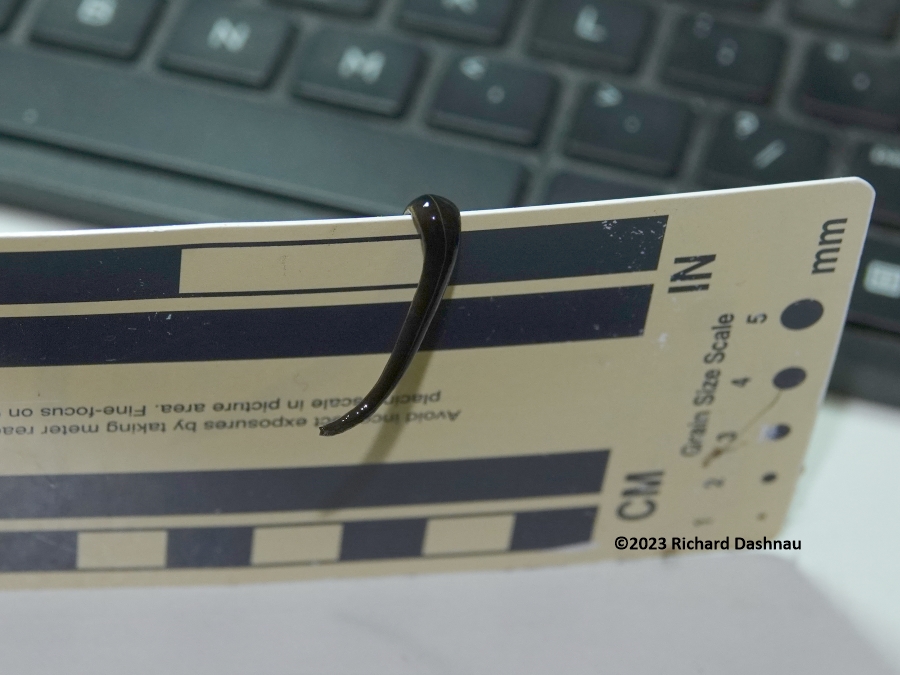
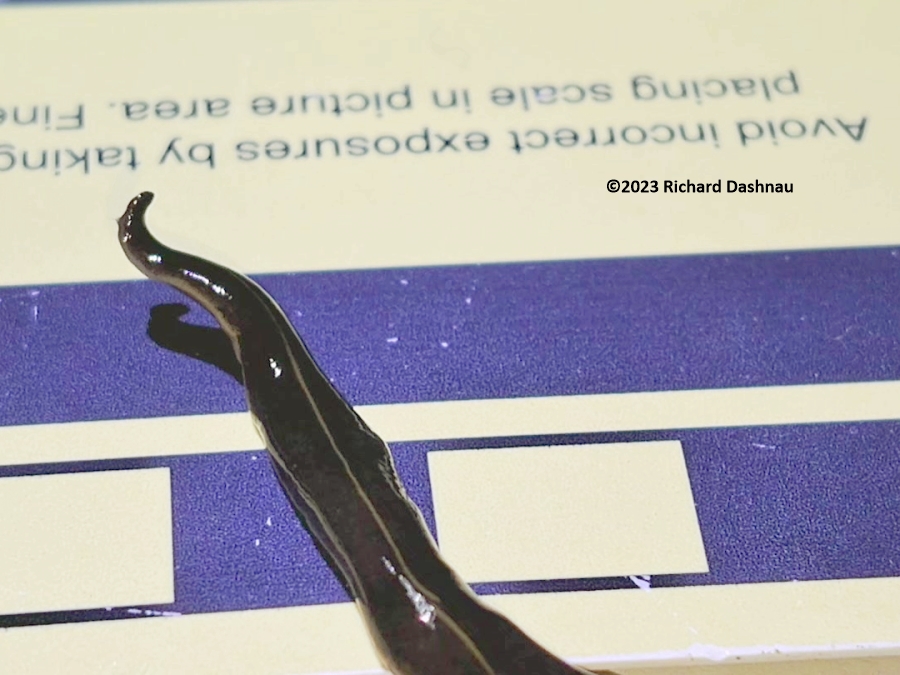
I'd
never
heard of this species before, and its movement was fascinating.
Unlike the gliding movement shown by the hammerhead worm, this one
appeared to "pour"
itself along a surface. It would anchor with a
blob of itself, then push off from that blob. It would put
down multiple blobs, and bridge itself between them, raising its
underside a few millimeters as those sections poured forward.
P.
manokwari hunts by following a fresh slime trail left by snail. If it
finds a trail, it has a 50/50 chance of picking the right direction
(i.e. following the snail instead of going
along backtrail).
If the worm reaches the end of the trail and there's no snail, it will
turn and go the other way. It seems likely that it could overtake most
snails.
(Prey-tracking behavior in the invasive terrestrial
planarian Platydemus manokwari by Noriko Iwai & Shinji Sugiura
& Satoshi Chiba (2010))
Since this is also a land planarian, and
invasive, I made sure it was taken out of the environment by placing it
into a small specimen bag and placing it in the freezer.
Some of these images are frames from video, which I've edited into a
video file which is at this link.
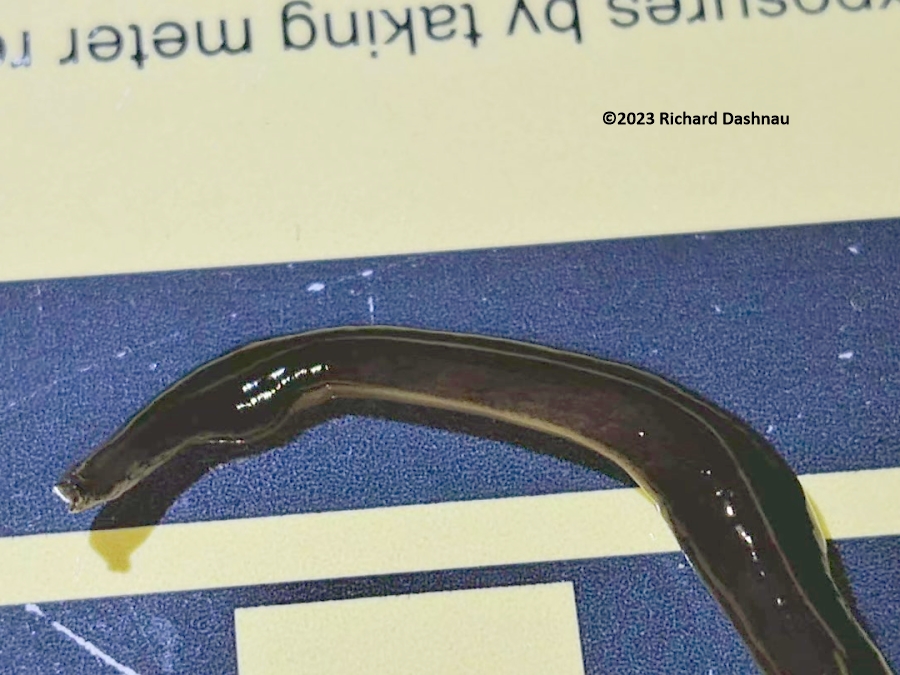
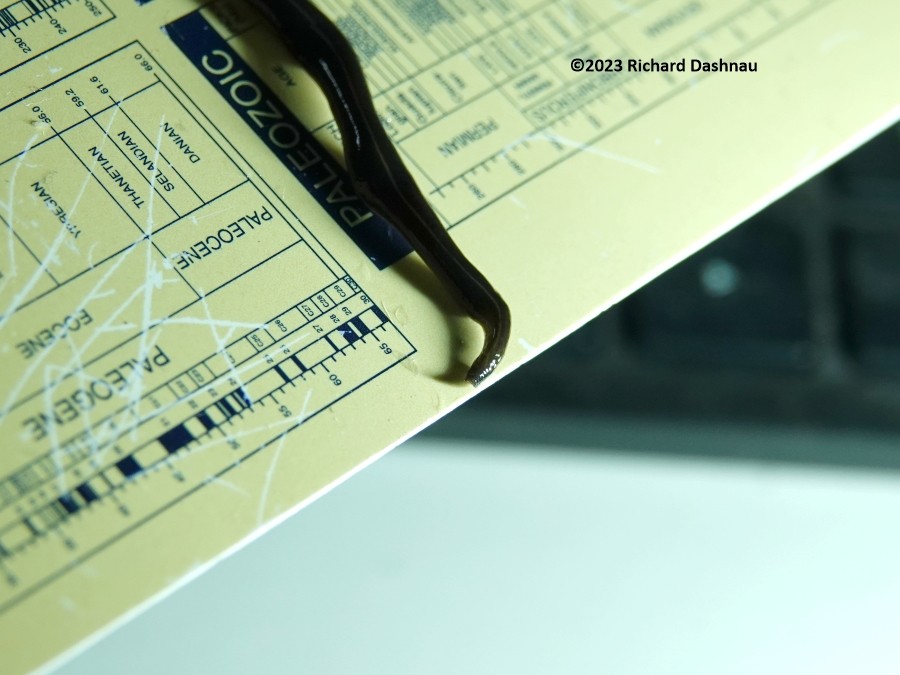
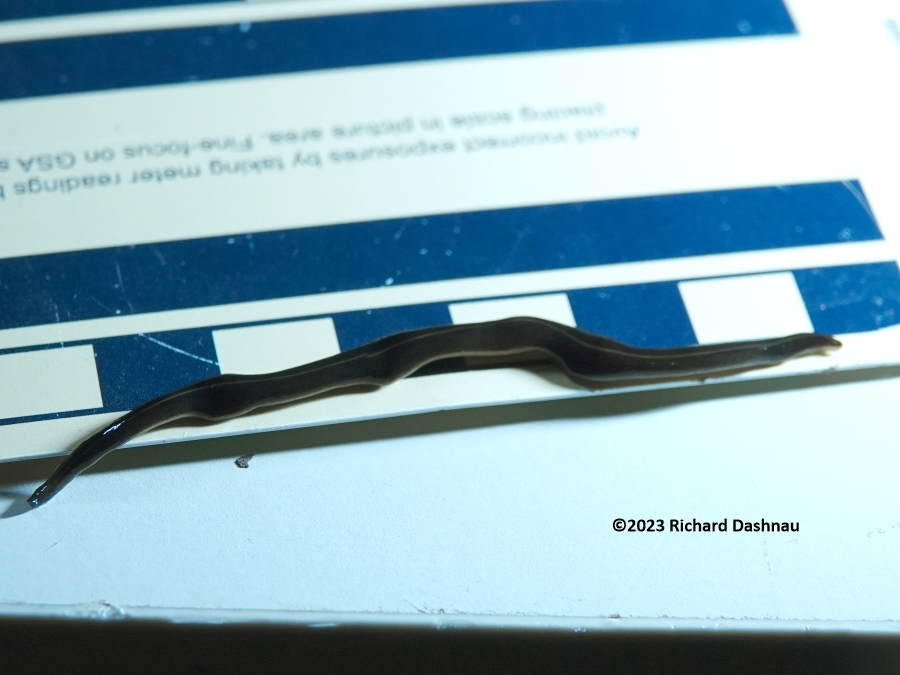
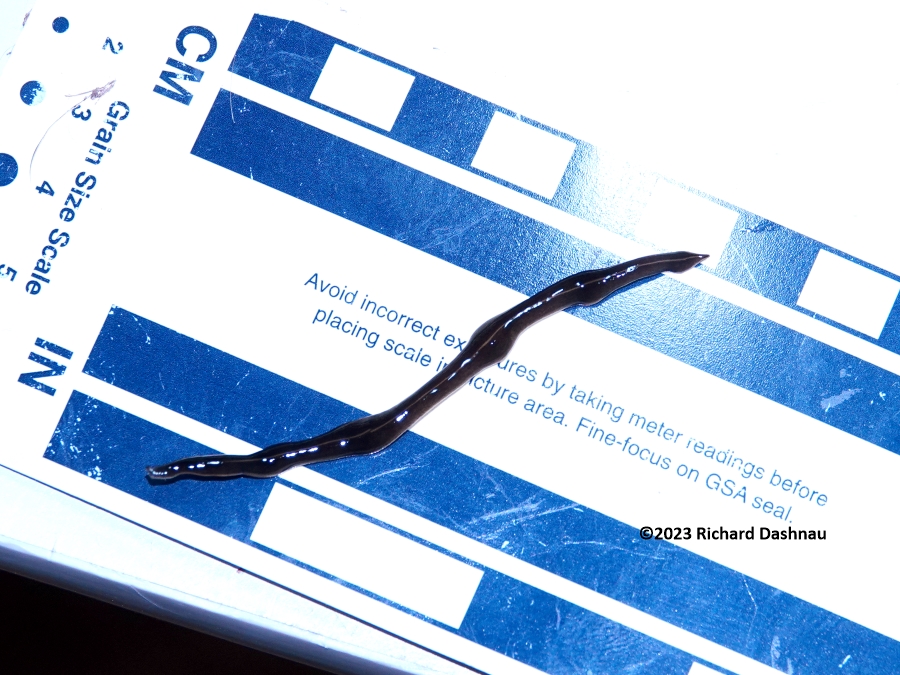
09/19/2021
--
I
was in Brazos Bend State Park, on the t-shaped fishing pier in 40 Acre
lake. I was watching an alligator that I noticed under the pier, to see
how it was
behaving while people were fishing from the pier. I
also like to see what kinds of fish people catch, if they catch
anything. As some more walked up, one of them looked
at the
alligator below me, and asked if it had a leech on it. I've
seen
leeches on Alligators at Brazos Bend State Park often, so when I
examined the alligator I expected
to see leeches like the ones in these pictures from about 6 years
ago--11/01/2015.
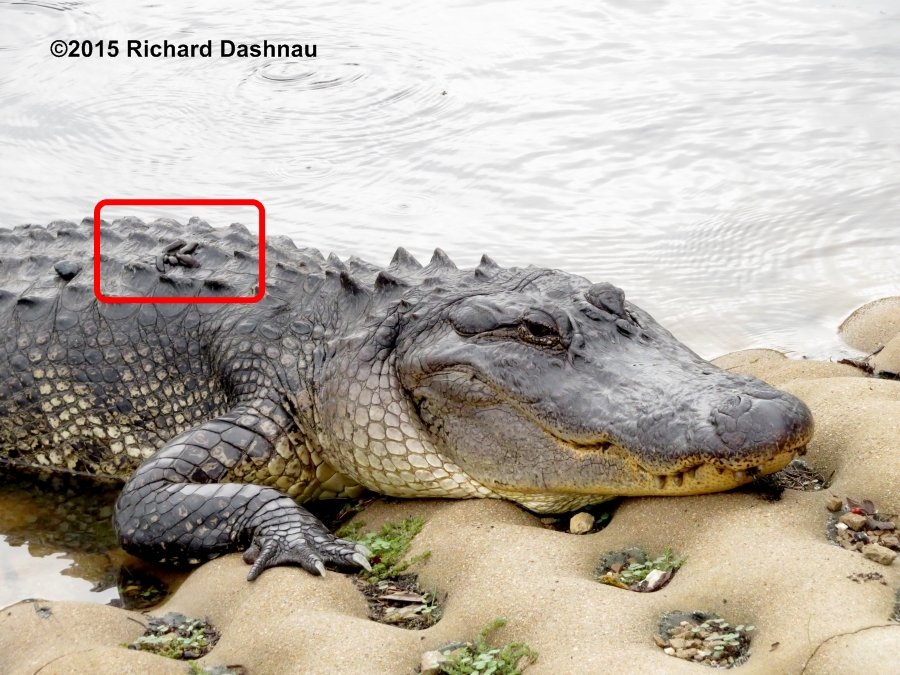
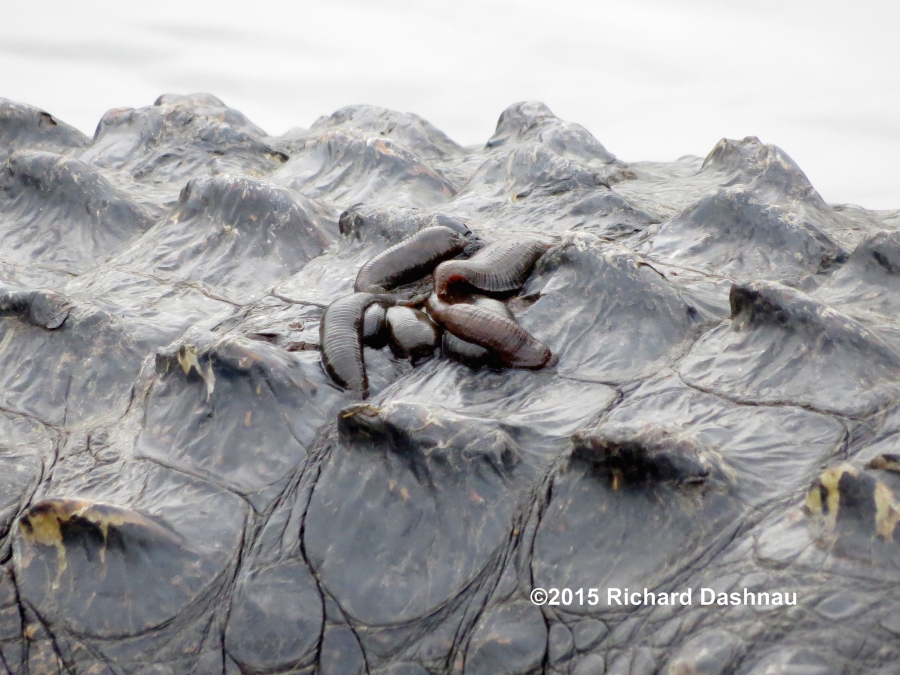
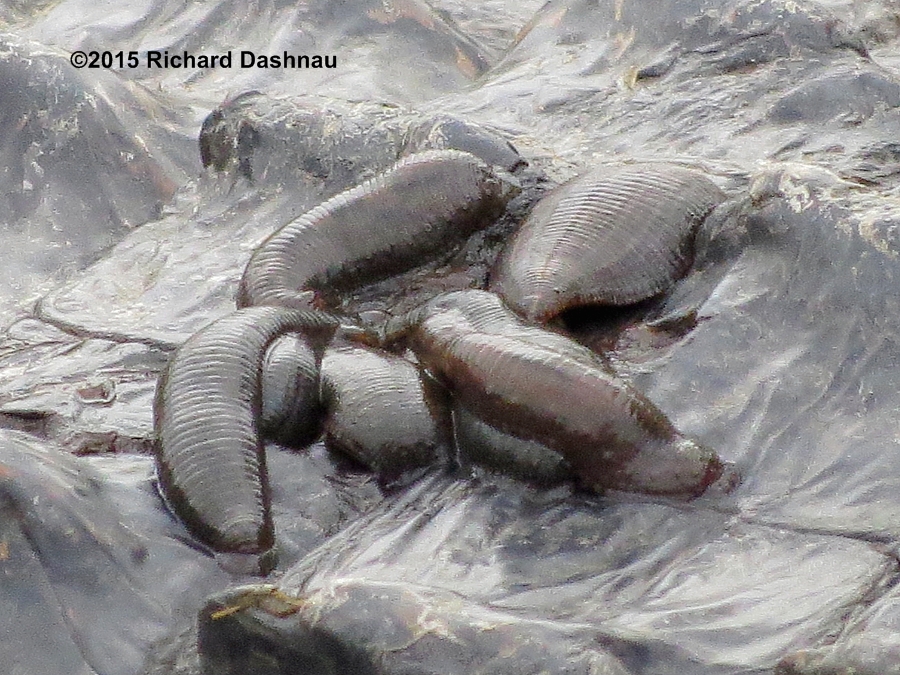
Alligator at Spillway 11/01/2015
Leeches
are probably on a
wound 11/01/2015
Pile of
leeches on the gator
11/01/2015
It
took
me longer than it should have to find the leech, since I was
looking for something dark grey or black. When I finally
found
the leech, I was very surprised. I can't recall ever
seeing
anything like this at BBSP. The alligator was in the water,
so I
tried my best to get zoomed-in photos. The pictures below
show
the leech. Multiple views show that the leech
was moving, and alive.
By the way, there are two alligators in the picture. There was a brief,
low-key confrontation between them when one tried to "share" the pier
with the one that
was already there. It was eventually chased away by the gator that had
been there when I'd arrived.
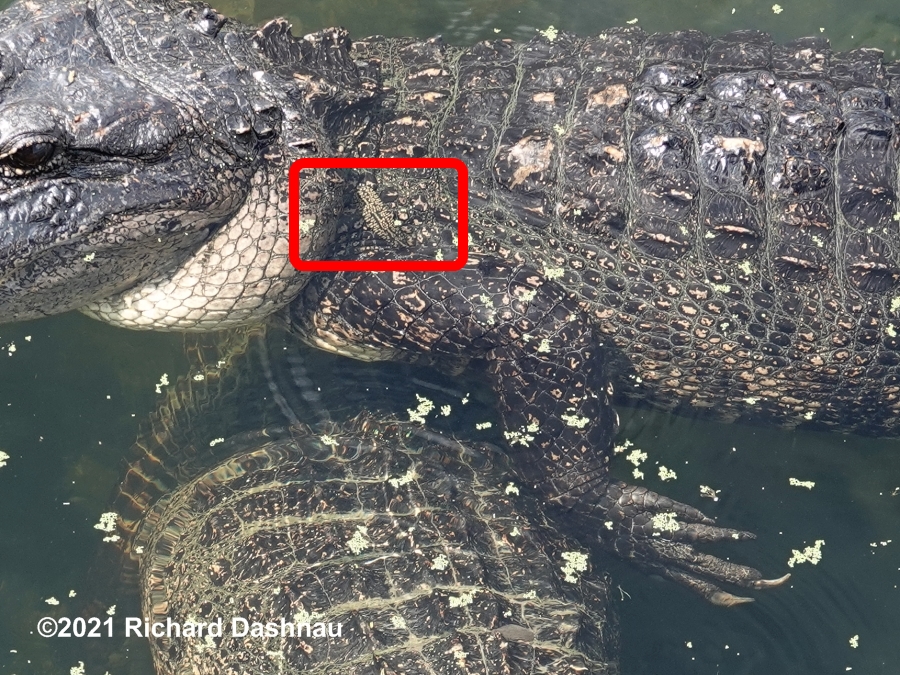
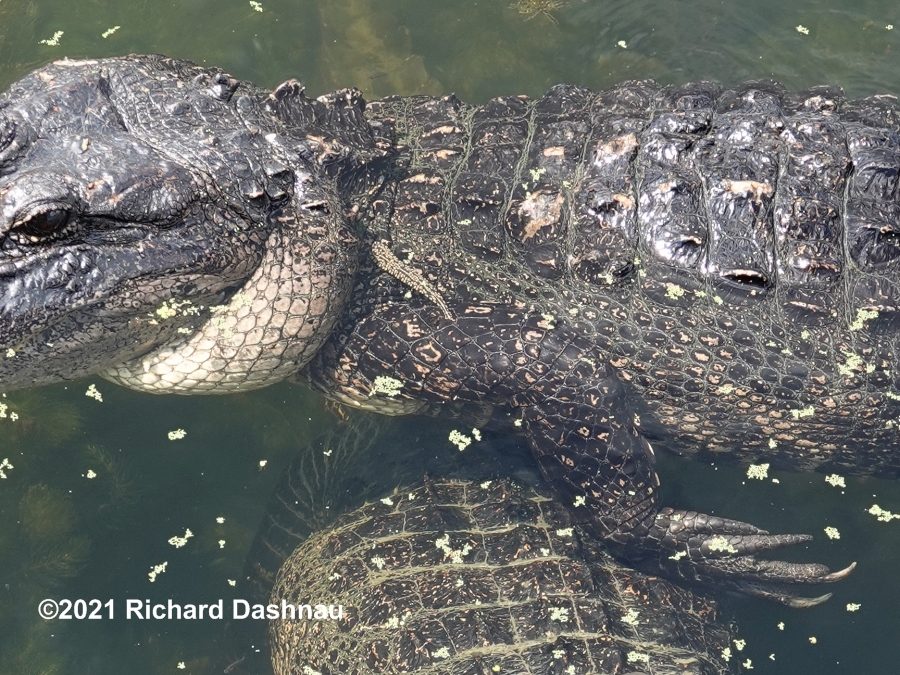
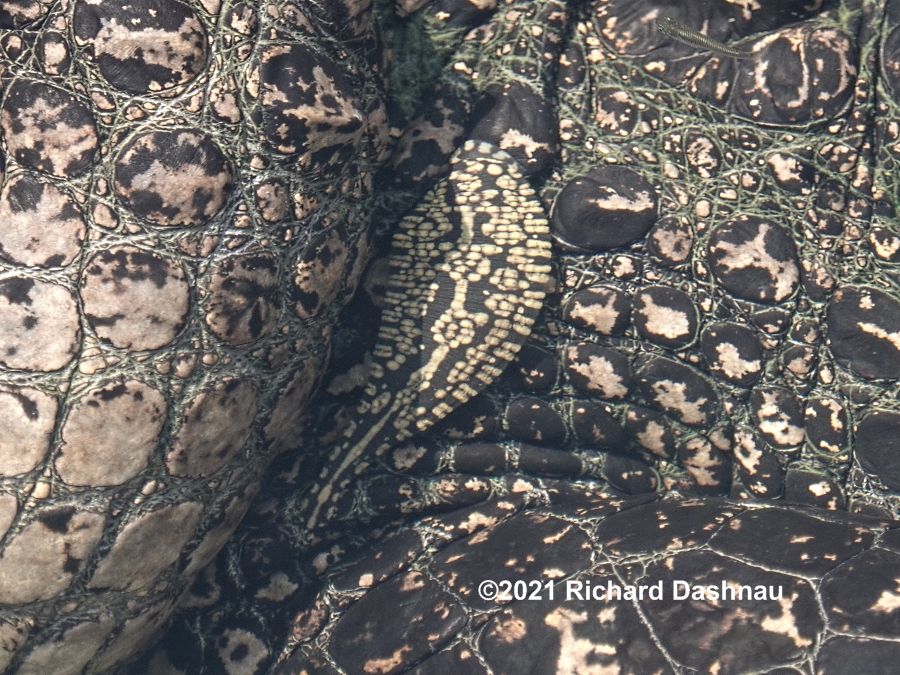
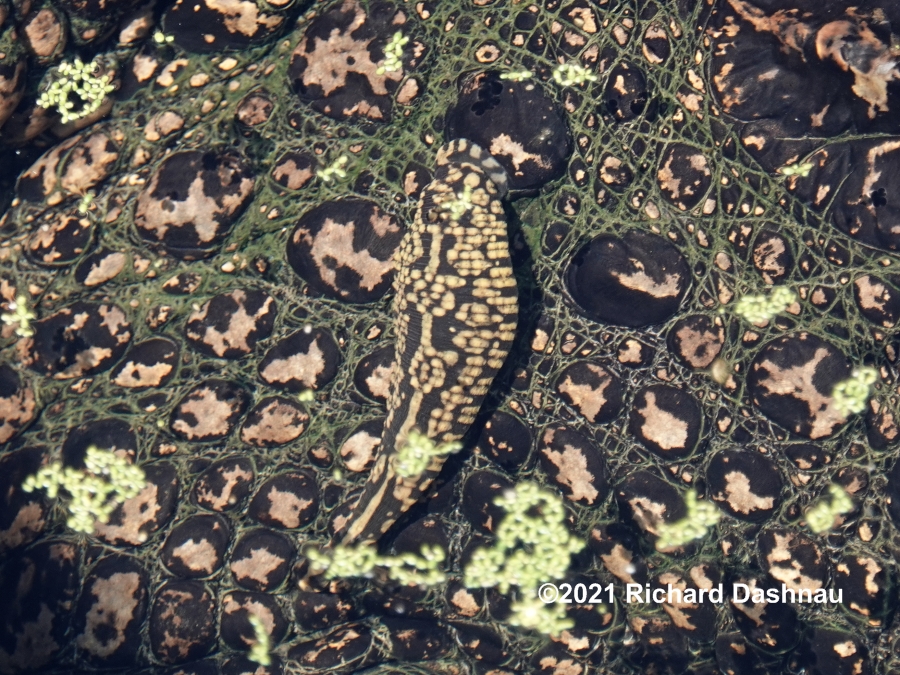
Turtle
leech on a gator 09/19/2021
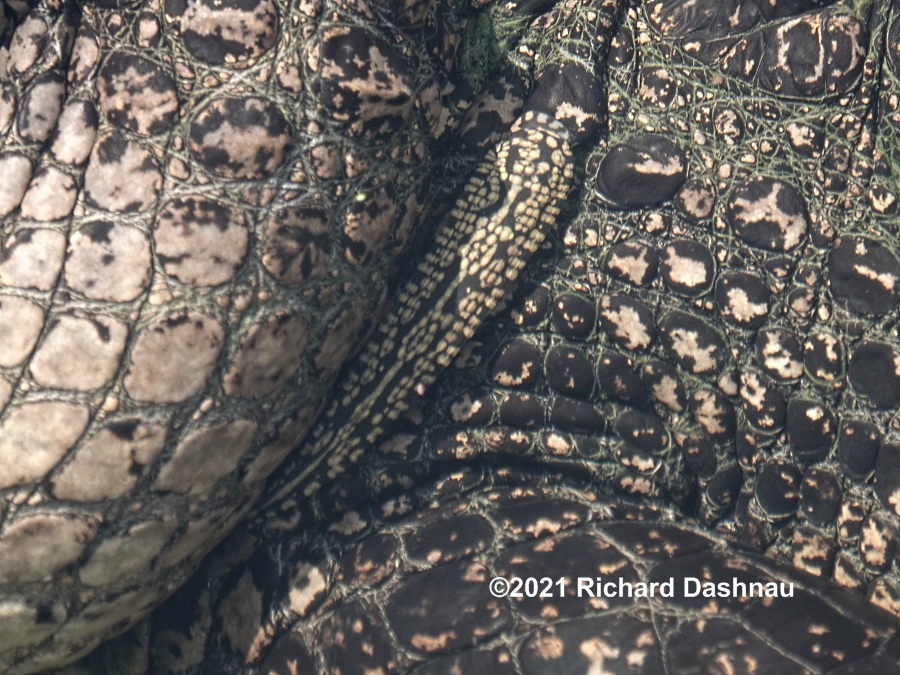
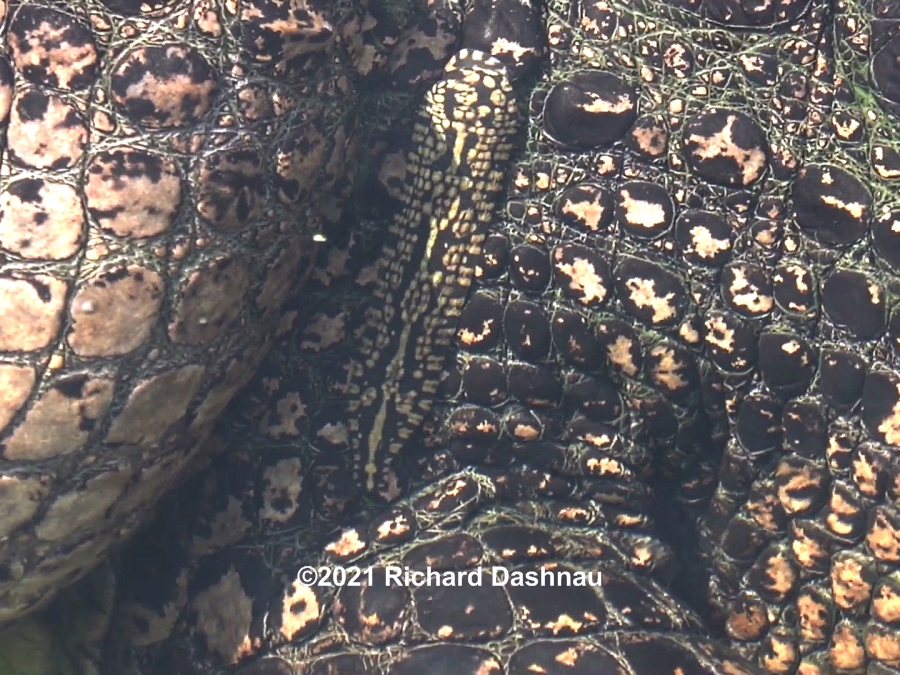
I
looked around online, and I am still surprised by the apparent lack of
published literature describing leeches. From what i could find, it
seems that this is called a "Smooth Turtle Leech",
(Placobdella
parasitica),. I found a few mentions indicating that these
leeches normally prey on turtles. The one I saw was obviously
not
riding on a turtle, but didn't appear to be
feeding, either. If it
was, I think the smaller end (where the mouth is) would have been
attached to the alligator. It's not unlikely that the leech
was
just riding. This was an uncommon
sight for me. Of course, the leech was attached to an alligator
and alligators are always amazing. UPDATE-- I
posted this little story and a few pictures on Twitter, and the "fancy
leech"
was apparently pretty popular for a while. Biologist
Danielle
dDecarle (@danielledecarle) supplied verified I.D. as
Placobdella
parasitica. Herpetologist Arik Hartmann (@AmphibiArik)
linked me to
this paper: "Observations on the Leech Placobdella ornata Feeding From
Bony Tissues of Turtles" by Mark E. Siddall, Eugene S. Gaffney (link to abstract is here)
The paper
describes a different species than "fancy leech", but it feeds on
turtles. However, P. ornata attaches to a turtle's shell
(since P. parasitica "fancy" attaches to legs, tail, etc.--taking the
preferred
feeding
areas. Then, it probes between the sheets of horny external
covering
until it hits the bones underneath. Somehow (possible by dissolving
with its saliva) the leeches erode the bone until
they reach the blood vessels inside bone...and then drink the blood
that comes out.
Horsehair Worm
12/24/2006---It's
cold and nasty this morning--well at least for the Houston area.
After
spending 3 hours outside in the misty dampness, I was walking up
the
sidewalk
to the Visitor/Nature
center at Brazos Bend State Park. As I passed over
a puddle of water, I noticed movement just at the lower edge of my
vision.
When I stopped to look, I saw long, thick hairs moving in the
water.
I
got
excited when I saw these, because I'd read about them some time
ago.
They
were Horsehair Worms. Horsehair Worms (or Gordian Worms,
named after
the Gordian Knot of
legend because mating worms become a huge tangle) are
classed as "nematomorphs". All of the information I can find about
them
comes from the internet, so of course needs to be
verified. However, some
of the internet sources are uploaded scientific papers, so much of
the
information available is probably valid.
They
are parasites, usually of various invertebrates;
often arthropods like
insects. How they get into their hosts is still under discussion.
Some
feel that they are injested while the insect eats infested plant
material.
Perhaps a carnivorous insect
eating an infected herbivore can also become
infected.
In
any
case, the larva grow into an adult from inside the host, until the
parasite
is many times the length of the host.
Pretty nasty, isn't it.
As if that wasn't creepy enough--when the
worm matures, it then alters the behavior of the host so that it
will
end
up in water. This releases the worm, and the host usually drowns
afterwards.
The mechanism of this control
has
been under study. The worm chemically alters the function of the
host
somehow,
and it ends up in water. How the host is drawn to water, or even
if it
is
drawn
to water, or some other mechanism is at work, is unknown.
Sometimes
these worms are found when an insect is crushed. If the insect is
eaten
by a larger vertebrate, such as a frog, the worm
will sometimes crawl out
of the predator!
Horsehair
worms are harmless to humans, and according to some sources are
somewhat
beneficial because they kill certain insects. Of course,
I
already
knew that before I picked one up.
In
keeping
with
the alternate title for this page (Rick, don't touch THAT!), there
is the image below left.. Here some more images as
well. There's
also a short video clip (4,887
kb,
wmv) showing what one looks like moving in the palm of my
hand,
and on the ground.
--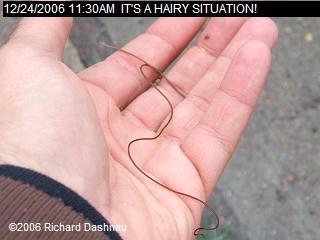 --
--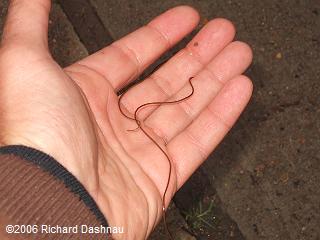 -
-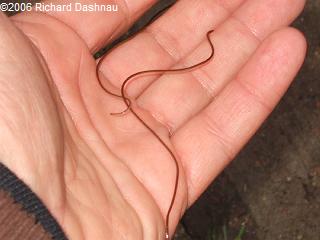 -
-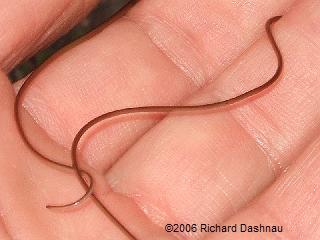 -
-
DON'T
TOUCH THAT!-------
GIVE
ME SOME
SKIN
-WELL,
IT'S SKINNY
CLOSER
LOOK
-----------------------------------------------------------------------------------------------------------------------------------------------------------------------------------------if--
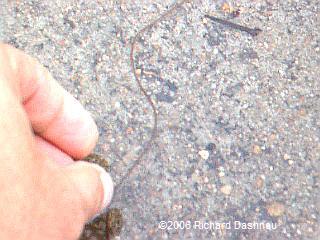
PICKING
UP THE WORM
VIDEO
CLIP
(4,887 KB WMV)
I
don't
often link to external pages for a number of reasons, but this is
such
a unique creature that I'm including some external links on this
page.
You can also find your own by searching for
"horsehair worm", "gordian
worm", or "nematomorph". I've also seen video clips on
youtube and
google video.
Here
are some links: (the
links I had all died, but I first wrote this in 2006 (15
years ago--today is 9/24/2021. So, no
links--but the internet has sure grown since then.)
Hammer-Headed Worm (Land Planarian)
First
appeared on my page July 3, 2001 Updated
06/23/2015
It
started
with a comment by my friend Don about something he'd found and
killed
in
his garden. He described it as some kind of "hammer-headed
worm".
Well, of course, that aroused my
curiosity. People that know me always
tell me things like this, probably because they know it drives me
crazy
if I don't know what it is. Anyway, this was sometime last year
(2000),
and as soon
as I got time, I started looking around. I searched the internet.
The
creature in question was described as slimy, maybe about a foot
long,
with
an odd, hammerlike head. Don didn't really have
many other details,
and he'd disposed of the thing over the weekend. I might have
driven
him
crazy asking if he'd seen any other ones for some months after. I
looked
through anything I could think
of, starting at reptiles (legless lizards
and skinks) and working towards simpler animals, like amphibians,
and
various
segmented worms. (I was thinking perhaps some kind of
sandworm-type
creature)
But, I couldn't find anything that matched the description. But, I
didn't
forget.
Then
Don mentioned that he'd found another one, and he'd tried to catch
it,
and keep it with some dirt. It dried
out very quickly, though, and once
again was thrown away.
Then,
during a search for something else (I can't remember what), I
found
this
web
page. The page describes a creature called a "land
planarian".
This is a "flatworm", a LARGE flatworm. Flatworms are considered
"less
complex" animals than segmented worms (and that's as where I'd
stopped).
I showed the image to Don, and
he thought that that was the creature. This
all happened last year. Today--
July 3, 2001-- Don found more of the critters in his garden. This
time though, he took some pictures, and sent them to me.
And he gave me
permission to use them on a website. (Remember, all the pictures
he
took
are used on this page BY PERMISSION.) So here are the
pictures of
the extremely weird beast in his
garden. Click on the images to see
them larger.
---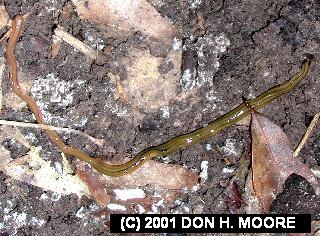 --
--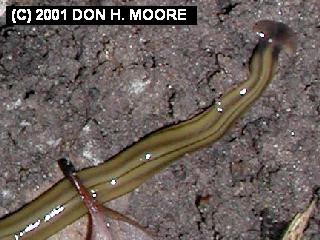
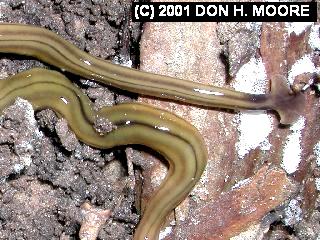
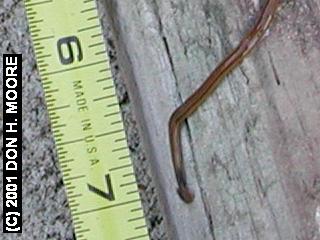
Full
view of the land
planarian.
Closeup
of the head.
Another
view of the flatworm. View
with a tape measure. Look at the length of this thing!
Click
here
for an
even larger view.
Here are some more links with information
about flatworms.
University
of
Florida (same link as above.)
Texas
A
&
M
One thing I've seen that seems to be important about these worms,
is
that
they pose a grave danger to earthworm
populations
within their range. I've also seen that there seems to be
no
way to kill these, either. Their occurrence in
Houston
could be cause for concern. Since I've only been able
to
verify this today, more research is pending. This
page
will be updated as I get more information. According to the TAMU
website, this planarian is Bipalium kewense. It is easily
identified by
the long striping along the body.
Click to go back to the See
the
World Page.
Click
to go to the Just
Rick Page
Click
to go to my Home
Page





























 --
-- -
- -
- -
-

 --
--

